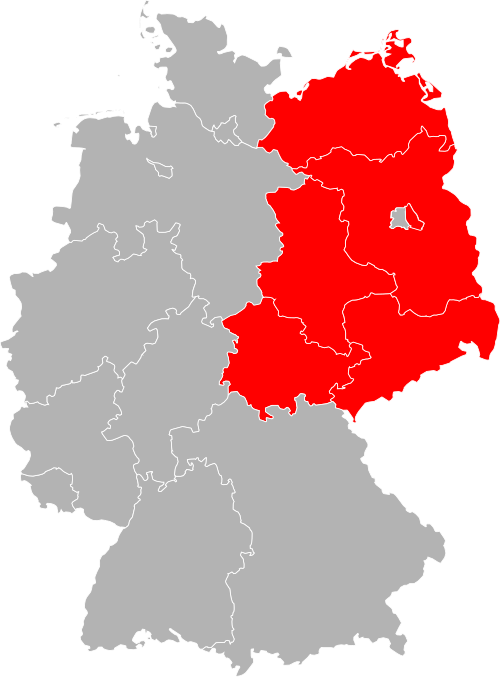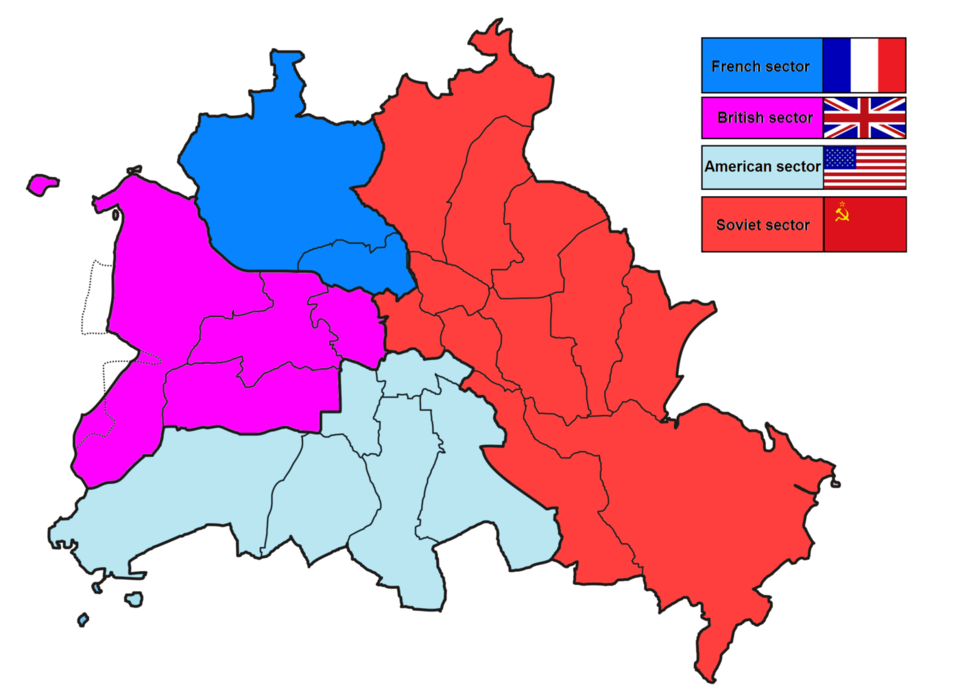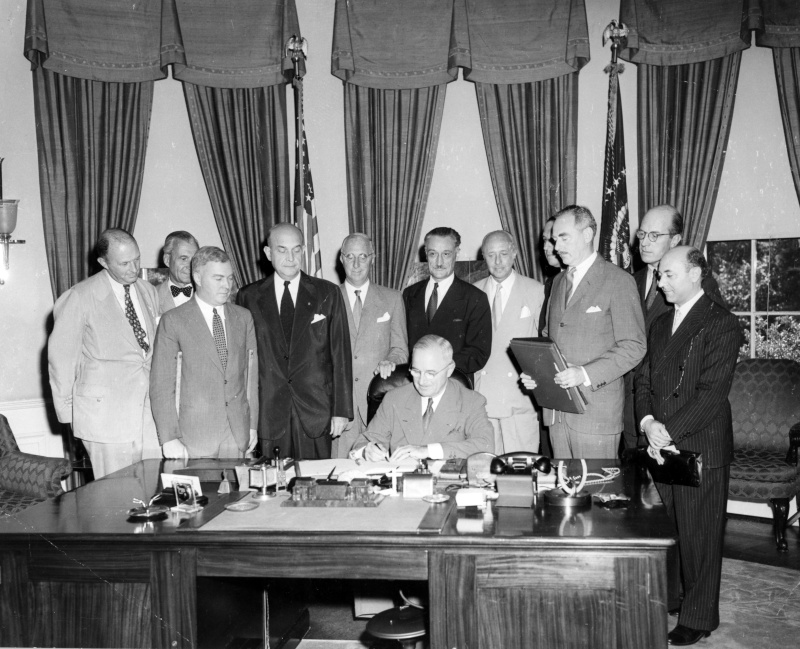OCR Specification focus:
‘creation of West and East Germany; NATO’
The division of Germany and the formation of NATO symbolised the entrenchment of the Cold War, shaping post-war Europe’s political and military landscape until 1991.
The Division of Germany After the Second World War
Following the defeat of Nazi Germany in 1945, the Allies had agreed at Yalta and Potsdam to temporarily divide Germany into zones of occupation. These zones were administered by the United States, the United Kingdom, the Soviet Union, and later France. Initially, the division was seen as a pragmatic arrangement, but by 1946–47, it had become clear that deep political and ideological differences made long-term unity unlikely.
Western Zones and the Push for Stability
In the Western zones, the Allies sought economic recovery and political stability. The Marshall Plan provided financial assistance, while the currency reform of 1948, which introduced the Deutschmark, revitalised West Germany’s economy. This move was seen by the Soviets as provocative and contributed to the escalating division between East and West.
Soviet Zone and Communist Control
The Soviet zone pursued a very different course. The Socialist Unity Party (SED) was formed in 1946, merging the Communists and Social Democrats under Soviet pressure. Land reforms, nationalisation of industry, and political suppression consolidated Moscow’s control. Stalin hoped a united but socialist Germany might remain in the Soviet sphere; however, Western policies ensured that this prospect faded rapidly.
The Creation of the Federal Republic of Germany (FRG)
By 1949, the Western Allies supported the creation of a new democratic German state. The Federal Republic of Germany (FRG), commonly referred to as West Germany, was officially proclaimed in May 1949. Its capital was established in Bonn, and Konrad Adenauer became the first Chancellor. The Basic Law (Grundgesetz) ensured democratic structures, a strong federal system, and safeguards against authoritarianism.
Federal Republic of Germany (FRG): The democratic state established in May 1949 from the Western zones of occupation, with Bonn as its capital.
The FRG aligned itself firmly with the Western bloc, becoming a key recipient of US economic support and a partner in the emerging transatlantic alliance.
The Creation of the German Democratic Republic (GDR)
In October 1949, in response to the establishment of the FRG, the Soviets declared the formation of the German Democratic Republic (GDR), or East Germany. Its capital was East Berlin, and the SED controlled the political system. The GDR’s creation formalised the division of Germany into two rival states.

Map showing the post-1949 division of Germany, with East Germany highlighted and Berlin (east) indicated. This clarifies the geopolitical split between the FRG and GDR. Source
German Democratic Republic (GDR): The socialist state established in October 1949 from the Soviet zone of occupation, with East Berlin as its capital.
The GDR was characterised by centralised economic planning, collectivisation, and strict political control under Soviet oversight. While the FRG claimed to represent all Germans, the GDR became the institutional embodiment of Soviet dominance in Eastern Europe.
The Berlin Question
Berlin, though located within the Soviet zone, was divided into four sectors. Tensions crystallised with the Berlin Blockade (1948–49), when Stalin attempted to force the Western Allies out by cutting off supply routes. The Berlin Airlift demonstrated Western resolve, supplying the city by air for nearly a year. This episode cemented Berlin as a focal point of Cold War rivalry and made the city a symbol of ideological confrontation.
The city remained under four-power rights and supervision despite being deep inside the Soviet occupation zone.

Map of Berlin (1945–1990) showing the American, British, French, and Soviet sectors. It illustrates why Berlin remained a jointly administered city despite the wider FRG/GDR division. Source
NATO and the Western Alliance
As the division of Germany hardened, Western leaders sought a military alliance to deter Soviet expansion. In April 1949, the North Atlantic Treaty Organisation (NATO) was established.

President Harry S. Truman signs the proclamation implementing the North Atlantic Treaty, with Allied representatives present. This marked the formal launch of NATO’s collective-security system in Washington, D.C., 24 August 1949. Source
North Atlantic Treaty Organisation (NATO): A military alliance formed in 1949 to provide collective defence against potential Soviet aggression, based on the principle that an attack on one was an attack on all.
Key Principles of NATO
Collective security: Article 5 committed members to defend one another in the event of attack.
Transatlantic unity: The presence of the United States guaranteed Western Europe a powerful protector.
Integration of West Germany: NATO’s formation laid the groundwork for West Germany’s eventual rearmament and membership in 1955.
Consequences of Division
The creation of two German states and NATO deepened the Cold War divide in Europe.
Political Consequences
The FRG became firmly integrated into the Western democratic camp.
The GDR emerged as a Soviet satellite, tied into the Eastern bloc.
Germany, once the centre of European instability, became the central theatre of Cold War rivalry.
Military and Strategic Consequences
NATO institutionalised Western military cooperation.
The Soviet Union responded by strengthening its control over Eastern Europe, leading eventually to the Warsaw Pact (1955).
Germany became a front line in the Cold War, with the Iron Curtain running through its territory.
Social and Economic Consequences
West Germany experienced rapid economic growth, known as the Wirtschaftswunder (economic miracle), thanks to integration with Western markets.
East Germany, though industrially strong, faced economic stagnation and emigration pressures.
Berlin became the starkest visual representation of division, later marked by the Berlin Wall (1961).
Importance in Cold War Development
The creation of West and East Germany, coupled with NATO’s establishment, marked the irreversible division of Europe into rival blocs. It signalled the failure of post-war cooperation and entrenched the bipolar order that would dominate international relations for decades. For OCR students, this subsubtopic highlights how geopolitical strategy, economic policy, and ideological rivalry combined to shape Europe’s Cold War trajectory.
FAQ
Bonn was selected as the provisional capital in 1949 because Berlin, though historically significant, was located deep within the Soviet zone. Berlin’s divided and unstable status made it politically unsuitable.
Bonn also symbolised a temporary solution, reinforcing the idea that the FRG did not consider the division of Germany permanent. This choice emphasised hopes for eventual reunification.
The establishment of the GDR formalised the division of Germany, which had previously been seen as reversible.
It deepened mistrust between the superpowers:
The West saw it as proof of Soviet expansionism.
The USSR argued it was a defensive response to the FRG’s creation.
This mutual suspicion hardened the Cold War divide.
Konrad Adenauer, the first Chancellor of the FRG, prioritised integration with the West over reunification in the short term.
His policies included:
Strengthening ties with the United States and Western Europe.
Supporting NATO membership and rearmament.
Overseeing the “economic miracle” through stability and reform.
Adenauer set the FRG firmly on a Western-aligned path.
Joining NATO in 1955 tied West Germany’s security directly to the United States and Western Europe.
This membership meant:
West German rearmament was legitimised within a defensive alliance.
The FRG gained international credibility and recognition.
Foreign policy focused on maintaining close cooperation with NATO allies to resist Soviet pressure.
Berlin was a microcosm of the Cold War: divided into four sectors despite lying inside the Soviet occupation zone.
Its symbolism derived from:
Representing the broader ideological clash between capitalism and communism.
Acting as a testing ground for East-West resolve, especially during the Blockade.
Serving as a constant reminder of Germany’s division, with competing claims to represent the German nation.
Practice Questions
Question 1 (2 marks):
In which year was the Federal Republic of Germany (FRG) officially created?
Mark Scheme:
1 mark for correct year: 1949.
Maximum 2 marks: award 2 if the student states “1949” and refers specifically to “May 1949” when the FRG was proclaimed.
Question 2 (6 marks):
Explain two reasons why NATO was established in 1949.
Mark Scheme:
Up to 3 marks for each well-explained reason (6 marks maximum).
Marks are awarded for:
Identifying a valid reason (1 mark).
Developing the reason with some explanation (additional 1 mark).
Linking the reason explicitly to NATO’s establishment in the Cold War context (further 1 mark).
Examples:
Reason 1: To provide collective security against potential Soviet aggression (1 mark). NATO’s Article 5 established the principle that an attack on one was an attack on all (1 mark). This reassured Western Europe that the USA would not withdraw into isolationism (1 mark).
Reason 2: To integrate and stabilise Western Europe politically and militarily (1 mark). NATO acted as a deterrent to Soviet expansion and supported economic recovery efforts such as the Marshall Plan (1 mark). This formalised the Western bloc and reinforced unity against communism (1 mark).

